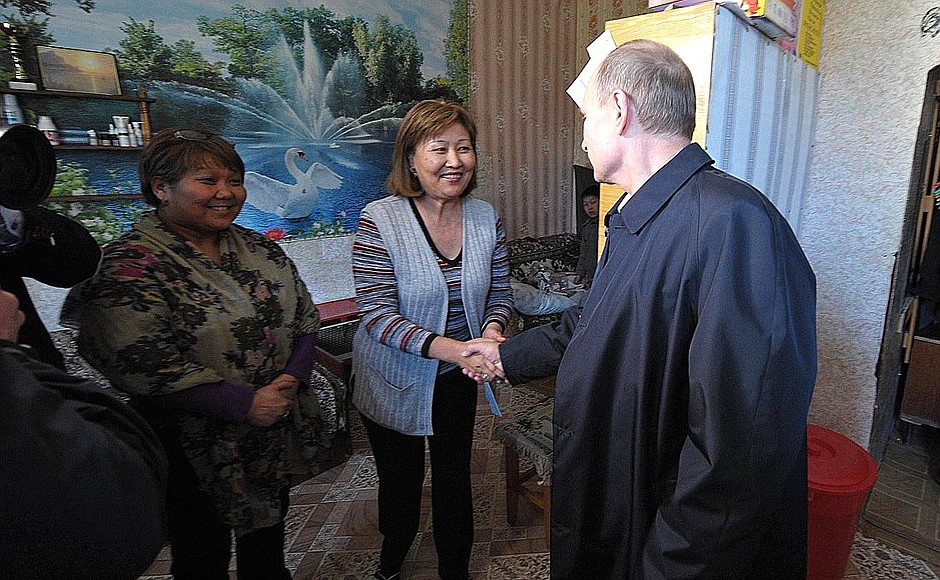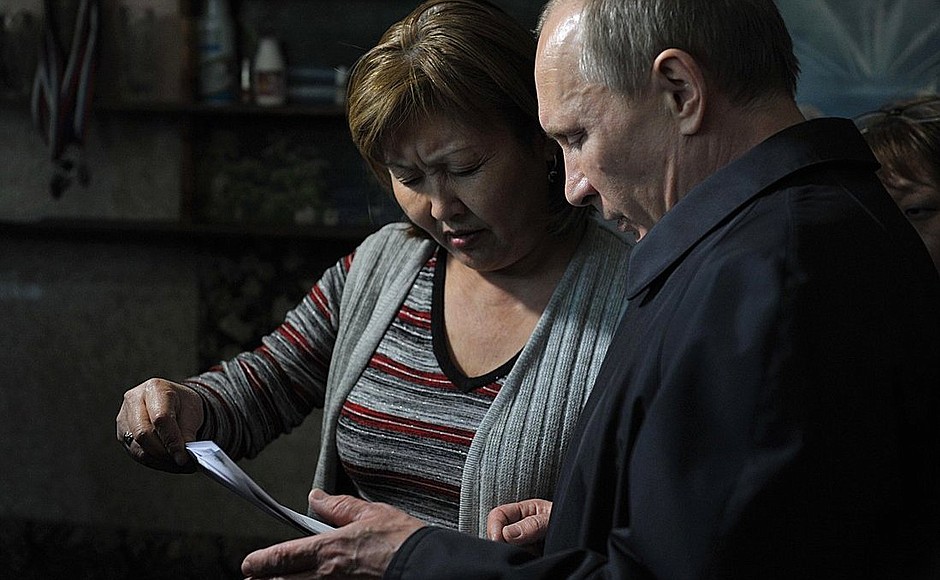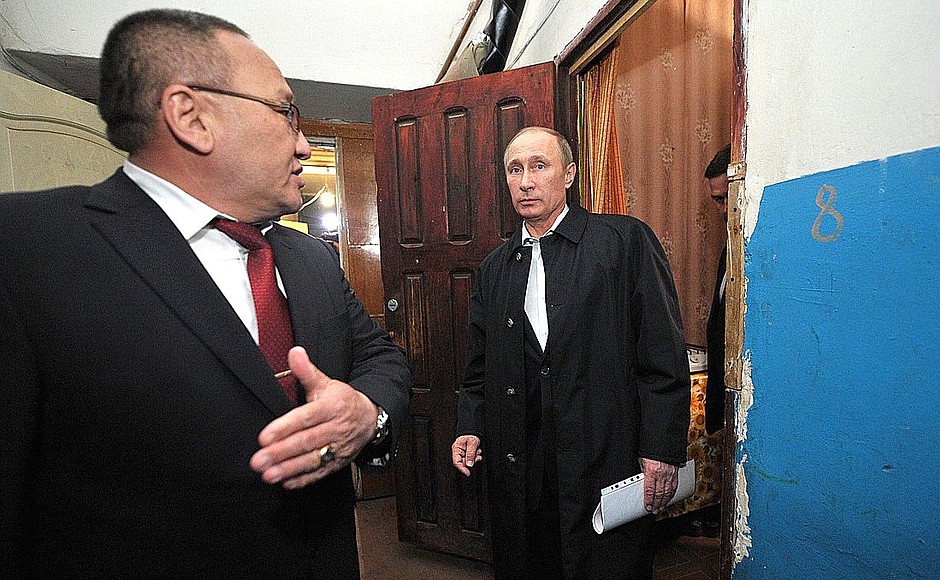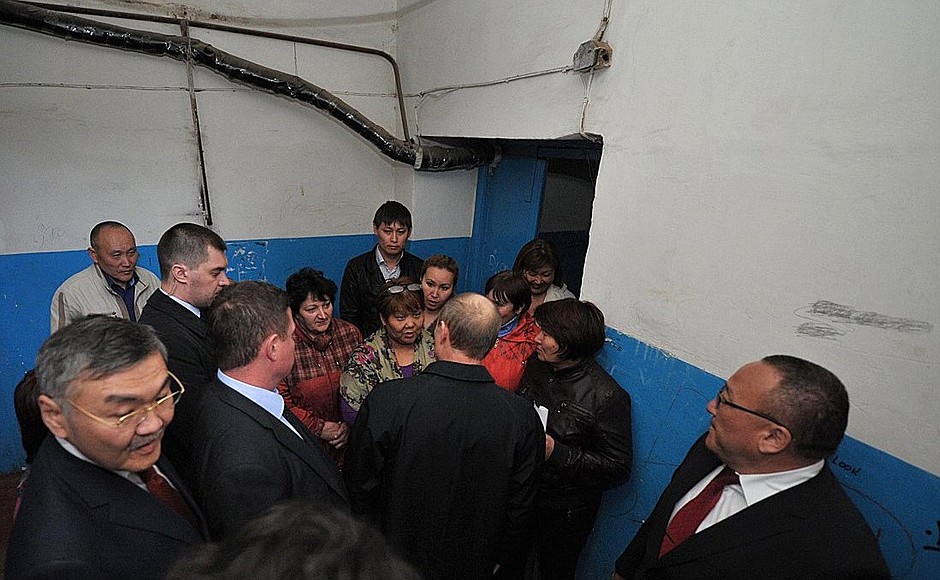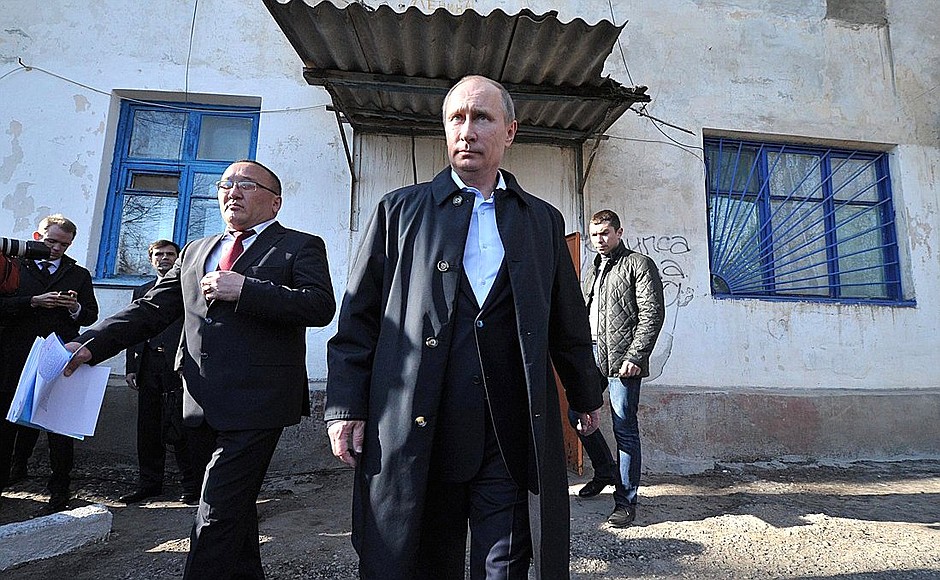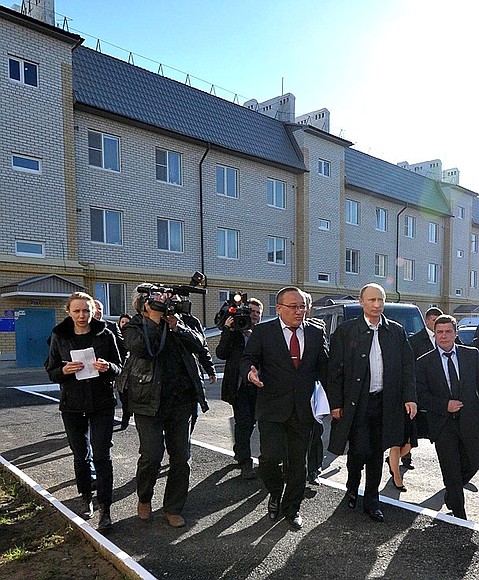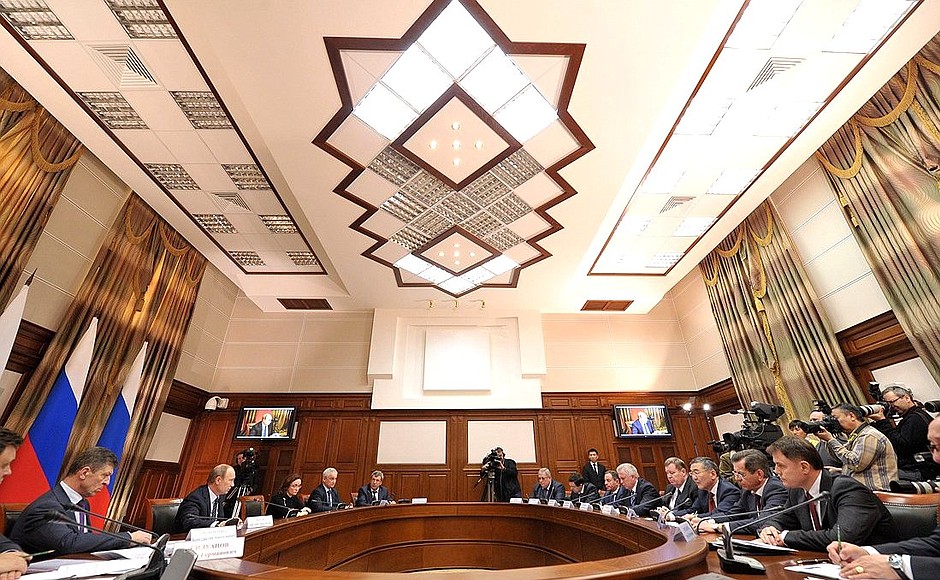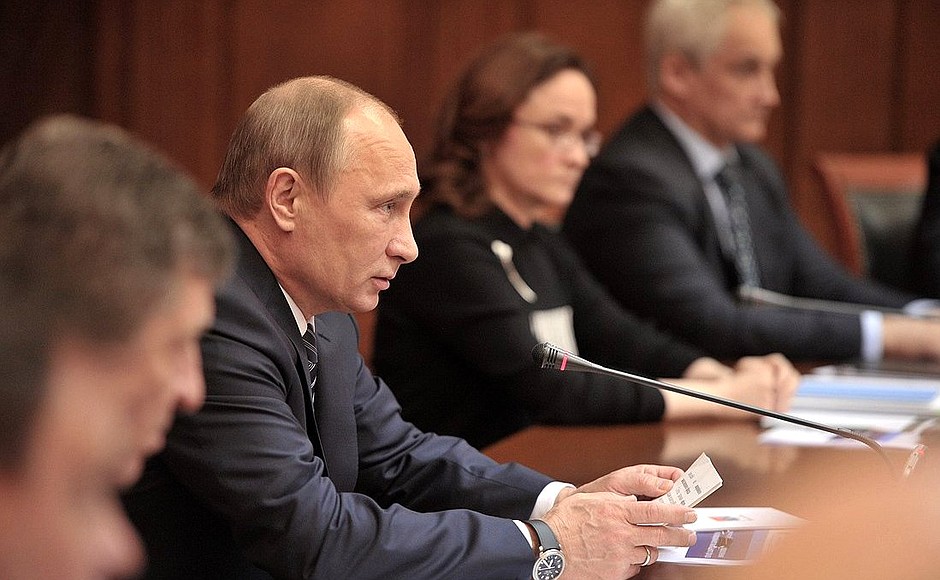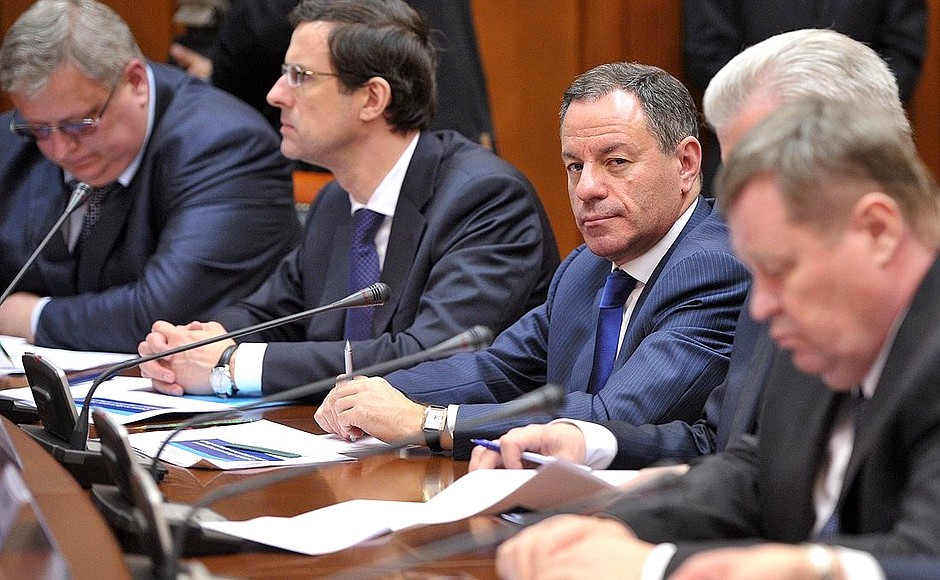The President noted that at the present time, tens of thousands of Russian families are forced to live in homes that do not meet the requirements of comfort and safety. Speedy resettlement of the residents of dilapidated housing is a key task of the authorities, Vladimir Putin said.
In the previous five years, residents of over 5.1 million square metres of dilapidated housing were resettled, and over 343,000 people received new flats. Vladimir Putin has set the task to eliminate double the amount of dilapidate housing in the coming years, and to resettle 720,000 people from dilapidated houses to new flats.
Before the meeting, the President visited one of the old houses whose residents are due to be resettled, as well as a new block of flats.
Opening remarks at the meeting
President of Russia Vladimir Putin: Good afternoon, colleagues,
We continue our series of meetings on a subject of key social importance: providing people with affordable and comfortable housing, and improving the quality of housing and communal services.
Today we will discuss the implementation of our plans for the resettlement of people from dilapidated housing. I have visited such so called homes on several occasions. Today, Head of Kalmykia Mr Orlov and I have seen how people live there, in these “residential” houses.
All of you have been working on this issue professionally for some time and I am sure you realise that these are inhuman living conditions. Russian citizens must not be forced to endure such conditions. Once again I want to repeat what I have said many times before: it is our priority and our duty to get people out of those houses, out of those slums.
Currently 0.5% apartment buildings are officially listed as dilapidated. That is about 13.1 million square metres of housing. Again, these are just the official figures, and they do not reflect the whole picture. Tens of thousands of Russian families are forced to live in homes that are below standard in terms of comfort and, more importantly, safety. The earliest possible resettlement of those people and the elimination of slums is, as I said, our primary task.
Over the previous five years, 159 billion rubles have been allocated for this purpose from the federal budget; over 343,000 people received new flats and residents of over 5.1 million square metres of dilapidated housing have been resettled. Now we must make the next, even more difficult step: all the people who as of January 1, 2012 were recognised to be residing in dilapidated housing must receive new flats. In total, about 720,000 residents of dilapidated apartment buildings will need to be resettled. Thus, the challenge for the coming years is to eliminate twice the amount of dilapidated housing as in the previous five years. This task was set in the executive orders of May 2012.
I propose that during this meeting we discuss the ongoing efforts in this area, the problems that arise, and what measures should be taken to address these problems. Naturally, the successful implementation of this goal requires vigorous and concerted action by all levels of government, and the main role is to be played by the Russian regions. Regional programmes for the resettlement of people from dilapidated housing designed for the next three years should have been approved by the regions by now.
The deadline had been set for April 15, 2013. However, only three regions have approved such programmes so far. Why is that? I want to put this question to our colleagues from the regions who are present here today, and, I hope, the other heads of Russian regions will hear me as well. Why only three regions have approved their programmes? What is the date today? The 16th? Where are your programmes?
We will talk about the problems. I know what they are, we have discussed them in Moscow many times, and have just reviewed them at a meeting here with Government members. I am well aware of the problems, including financial ones. But that is no excuse: you have signed an agreement with the Finance Ministry, so where are the programmes?
The Housing and Utilities Fund is scheduled to conclude agreements with the regions by May 15, 2013 to provide federal funding for these programmes; over 40 such agreements have already been signed. In total, 126.6 billion rubles will be allocated from the federal budget in the next three years for the elimination of dilapidated housing. I would like to highlight a very important point: starting in 2013, on the proposal of the Russian Government, the share of regional funds in the resettlement programmes is to increase significantly, from an average of 30% to 64%. With this regard, I would like to draw the attention of the Government to the fact that approximately 60% of dilapidated housing is located in regions with low fiscal capacity and mainly in the municipalities with acute economic problems, including single-industry cities and urban communities. I would like to ask you to share your thoughts today on how the increased load on the regional budgets will affect the implementation of programmes for the resettlement of people from dilapidated housing.
I also propose that we analyse the 2012 results of such programmes. I know that certain difficulties arose due to the regions’ failure to meet the deadlines for the resettlement and co-financing. For these reasons, the Housing and Utilities Fund did not approve some regions’ reports and suspended the funding. We must get to the bottom of what happened here: whether this was due to objective problems or mistakes. Each case should be considered separately, but it is necessary to conduct a systematic analysis of the situation. The people who are hoping to be resettled from dilapidated housing as soon as possible and are entitled to it, should not become hostages to inaction or failures of the various authorities.
Finally, one more issue I would like to mention: the order in which people are resettled. Dilapidated housing accumulation occurred over the years. Strictly speaking, this problem does not date back to the 1990s but emerged in the decades after World War II, if not earlier: in the 1940s, 1950s and 1960s. Now one third of dilapidated housing is apartment buildings that were classified as dilapidated before January 1, 2007. However, those buildings do not have priority status in the regional resettlement programmes.
The head of the region and Mayor of Elista Mr Dordzhiyev, and I have just talked with some people and we asked them how long they were living in such conditions. That was no accident. It turned out some of them were in such housing for 20 years, some for 30, and some for 40 years. Yet the regional resettlement programmes do not take into account the amount of time people have been living in dilapidated housing. I don’t think that’s very fair, or not fair at all. Let us make sure that a clear and realistic resettlement deadline is set for each building, that the residents are aware of this deadline and the authorities ensure that it is met.
I must say that I was pleased when one of the women said, “We expect to be resettled in September, and we have already visited our new homes and watched them being built.” That is normal, as it should be, and that is how our efforts must be organised.
Let's move on to a discussion of these issues.
<…>
